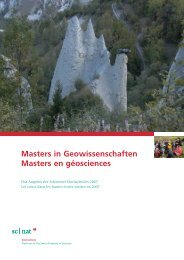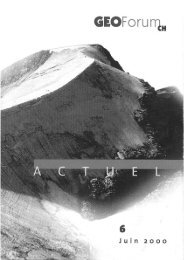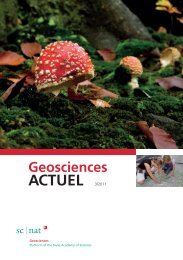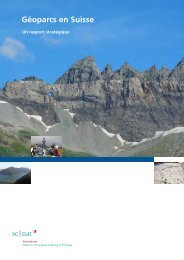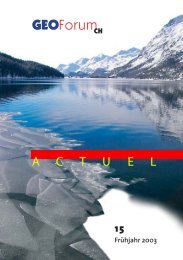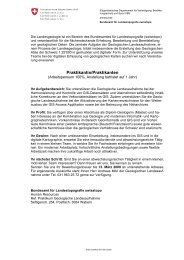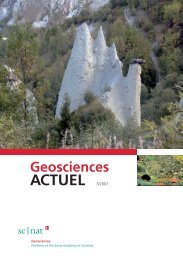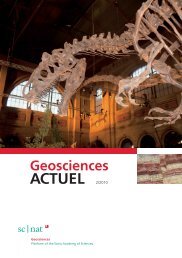geoconservation in switzerland - Platform Geosciences - SCNAT
geoconservation in switzerland - Platform Geosciences - SCNAT
geoconservation in switzerland - Platform Geosciences - SCNAT
Create successful ePaper yourself
Turn your PDF publications into a flip-book with our unique Google optimized e-Paper software.
GEOCONSERVATION IN SWITZERLAND<br />
General situation 2005<br />
(Designed for the expected European overview of ProGEO)<br />
Table of Contents<br />
1. INTRODUCTION (historical overview) ................................ ................................ .................. 1<br />
2. LEGAL BASIS................................ ................................ ................................ ....................... 2<br />
3. ORGANIZATION and POLICY................................ ................................ .............................. 2<br />
4. SITE SELECTION................................ ................................ ................................ ................. 3<br />
5. REGISTRATION and PROTECTION ................................ ................................ .................... 4<br />
6. MANAGEMENT and FACILITIES................................ ................................ .......................... 5<br />
7. CONCLUSIONS................................ ................................ ................................ .................... 5<br />
8. REFERENCES ................................ ................................ ................................ ..................... 6<br />
9. CONTACT ADRESSES ................................ ................................ ................................ ........ 7<br />
STÜRM, B. (2005): Geoconservation <strong>in</strong> Switzerland – General situation 2005. – GEOforumCH of<br />
the Swiss Academy of Sciences, Work<strong>in</strong>g Group Geotope.
- 1 -<br />
1. INTRODUCTION (historical overview)<br />
1993: The Work<strong>in</strong>g Group „Geotope Protection Switzerland“ (nowadays called “Swiss<br />
Work<strong>in</strong>g Group Geotope“) was founded and <strong>in</strong> the follow<strong>in</strong>g year <strong>in</strong>tegrated <strong>in</strong>to the organisation<br />
of the Swiss Academy of Sciences (<strong>SCNAT</strong>).<br />
1994: A national survey, carried out by the Swiss Work<strong>in</strong>g Group, showed a pattern of great<br />
differences <strong>in</strong> the development stage of <strong>geoconservation</strong> amongst the 26 cantons (member<br />
states of the Helvetic Confederation).<br />
1995: The Swiss Work<strong>in</strong>g Group developed a strategy to improve the state of <strong>geoconservation</strong>.<br />
The published Strategy Report (ARBEITSGRUPPE GEOTOPSCHUTZ SCHWEIZ 1995) shows, how<br />
the recognized deficiencies could be rectified.<br />
1996-1997: The Swiss Landscape Concept (BUNDESAMT FÜR UMWELT, WALD UND<br />
LANDSCHAFT 1998) was established by the Federal Adm<strong>in</strong>istration and approved by the Federal<br />
Council <strong>in</strong> December 1997. It seeks to achieve susta<strong>in</strong>able landscape development. Amongst<br />
other fields it conta<strong>in</strong>s <strong>geoconservation</strong> as an <strong>in</strong>tegral part. The concept shall promote a dialogue<br />
between landscape users and conservationists and thus create and support favorable alliances.<br />
It serves as an official guidel<strong>in</strong>e with b<strong>in</strong>d<strong>in</strong>g objectives.<br />
1998-1999: The Swiss Work<strong>in</strong>g Group elaborated a first comprehensive National Indicative<br />
List (ARBEITSGRUPPE GEOTOPSCHUTZ SCHWEIZ 1999) with geotopes of potential national significance<br />
(for further <strong>in</strong>formations look at chapter 5).<br />
2000: The Swiss Agency for the Environment, Forests and Landscape (SAEFL) and the Federal<br />
Office for Water and Geology (FOWG) constituted the Work<strong>in</strong>g Group „Geotope<br />
BUWAL/LHG“ <strong>in</strong> order to promote the aspects of <strong>geoconservation</strong> with<strong>in</strong> the Federal Adm<strong>in</strong>istration.<br />
In a first step this work<strong>in</strong>g group prepared a concept for the protection of geotopes<br />
of national significance (GERBER, B. & GSTEIGER, P. 2000) which <strong>in</strong> particular conta<strong>in</strong>s a<br />
project description for an official national geotope <strong>in</strong>ventory.<br />
2001-2003: Two geotope-assemblages of <strong>in</strong>ternational significance were admitted to the<br />
UNESCO World Heritage List (WHL), the area „Jungfrau-Aletsch-Bietschhorn“ with the biggest<br />
alp<strong>in</strong>e glacier (2001) and the „Monte San Giorgio“ with its outstand<strong>in</strong>g triassic d<strong>in</strong>osaur<br />
fauna (2003). At the same time the „Glarner Hauptüberschiebung“, the most impressive overthrust<br />
of the Alps, was nom<strong>in</strong>ated as WHL-candidate.<br />
In adition to the mentioned development at national level, several <strong>in</strong>itiatives have been taken<br />
by cantons, regional plann<strong>in</strong>g organisations and municipalities and subsequently geotope<br />
<strong>in</strong>ventories, geoparks, geopaths and other geoprojects have been realized.
2. LEGAL BASIS<br />
A good overall view is given by JORDAN, P. (1999). The most relevant laws and articles relat<strong>in</strong>g<br />
to geotope protection can be described as follows:<br />
Federal Nature Conservation Act (SR 451):<br />
Art. 1 „Purpose“: e.g. protection of landscapes and natural monuments<br />
- 2 -<br />
Art. 5 „Inventories of objects of national significance“: e.g. the Federal Council has to set up <strong>in</strong>ventories<br />
of objects of national significance, like the Inventory of Landscapes of National importance<br />
(BLN).<br />
Federal Town and Country Plann<strong>in</strong>g Act (SR 700):<br />
Art. 6–12 „Structure plans of the Cantons“: They set the guidel<strong>in</strong>es for future development and<br />
are basic tools for the coord<strong>in</strong>ation of spatial <strong>in</strong>terests and impacts. Once approved, they are<br />
b<strong>in</strong>d<strong>in</strong>g for all authorities<br />
Art. 14-18 „land-use plans“: They stipulate <strong>in</strong> detail the possible land-exploitation. The territory<br />
has to be divided <strong>in</strong>to different zones. The ma<strong>in</strong> types of zones are: zones for build<strong>in</strong>g construction,<br />
zones for agricultural use and protection zones. Once approved, land-use plans are<br />
b<strong>in</strong>d<strong>in</strong>g for everybody.<br />
Art.17 „Protection zones“: Protection zones can be designated for brooks, rivers, lakes and<br />
their banks or shores, landscapes with outstand<strong>in</strong>g natural or cultural values, natural or cultural<br />
monuments and biotopes. Protection zones can be l<strong>in</strong>ked with nature conservation ord<strong>in</strong>ances<br />
which regulate <strong>in</strong> detail the specific protection needed. Approved nature conservation ord<strong>in</strong>ances<br />
are b<strong>in</strong>d<strong>in</strong>g for authorities, land owners and others, depend<strong>in</strong>g on their specific regulations.<br />
Instead of stipulat<strong>in</strong>g protection zones, other measures can be taken.<br />
3. ORGANIZATION AND POLICY<br />
Federal Office for Water and Geology (FOWG):<br />
www.bwg.adm<strong>in</strong>.ch<br />
The FOWG is the Confederation’s competence centre regard<strong>in</strong>g water use, water management,<br />
hydrology, geology and natural hazards.<br />
With<strong>in</strong> the FOWG the Geological Information Center is responsible for geotope <strong>in</strong>vestigation.<br />
Swiss Agency for the Environment, Forests and Landscape (SAEFL):<br />
www.umwelt-schweiz.ch<br />
The SAEFL is the federal government’s centre of environmental expertise. The ma<strong>in</strong> responsibilities<br />
are as follows: to provide a scientific basis for environmental protection measures; to<br />
draft laws and ord<strong>in</strong>ances; to promote susta<strong>in</strong>able development; to implement environmental<br />
protection measures <strong>in</strong> cooperation with cantonal authorities, non-governmental organizations<br />
(NGO’s) and other actors; to <strong>in</strong>form and advise the public, and last but not least, to promote<br />
global cooperation through <strong>in</strong>volvement <strong>in</strong> <strong>in</strong>ternational environmental bodies.<br />
With<strong>in</strong> the SAEFL the Division Nature and Landscape is responsible for the Swiss Landscape<br />
Concept, the Inventory of Landscapes and natural monuments of National importance (BLN)<br />
and geotope protection.<br />
Federal Office for Spatial Development (FOSD):<br />
www.are.adm<strong>in</strong>.ch<br />
The FOSD wants to make a fundamental contribution to susta<strong>in</strong>able spatial development <strong>in</strong><br />
Switzerland by play<strong>in</strong>g a strategic leadership role. Amongst others it is pursu<strong>in</strong>g the follow<strong>in</strong>g<br />
objectives: improvement of quality of life; susta<strong>in</strong>able development of urban and rural areas;
preservation of areas of outstand<strong>in</strong>g natural beauty and biodiversity; balanced regional development<br />
and spatial <strong>in</strong>tegration of Switzerland <strong>in</strong>to Europe.<br />
Relat<strong>in</strong>g to <strong>geoconservation</strong> the follow<strong>in</strong>g tasks of the FOSD are of special <strong>in</strong>terest: The implementation<br />
of the Alp<strong>in</strong>e Convention and the coord<strong>in</strong>ation of cantonal structure plans.<br />
- 3 -<br />
Swiss Academy of Sciences (<strong>SCNAT</strong>):<br />
www.scnat.ch<br />
The Academy is the most important platform for the dissem<strong>in</strong>ation and promotion of natural<br />
sciences. Its core mission is to raise the awareness of the role that natural sciences play <strong>in</strong><br />
provid<strong>in</strong>g solutions to society's current and future problems. The Academy aims at: facilitat<strong>in</strong>g<br />
<strong>in</strong>terdiscipl<strong>in</strong>ary cooperation and scientific exchange; improv<strong>in</strong>g public and media awareness<br />
and comprehension for natural sciences; encourag<strong>in</strong>g the dissem<strong>in</strong>ation of scientific research<br />
results; develop<strong>in</strong>g a swiss science policy; encourag<strong>in</strong>g <strong>in</strong>ternational scientific cooperation. To<br />
fulfil these goals, the Academy supports hundreds of activities and events each year, like conferences,<br />
symposia and public events.<br />
The SAS comprises 44 national specialized societies. It is the mother organization of the<br />
GEOforumCH.<br />
GEOforumCH:<br />
www.geoforum.ch<br />
The GEOforumCH is the platform for geosciences of the Swiss Academy of Sciences and serves<br />
as an <strong>in</strong>terface between the various discipl<strong>in</strong>es of geosciences, as well as between research,<br />
practice,adm<strong>in</strong>istrations, politics and the public. The missions of GEOforumCH are to<br />
<strong>in</strong>form:<br />
• researchers about developments <strong>in</strong> neighbour<strong>in</strong>g discipl<strong>in</strong>es<br />
• researchers about needs aris<strong>in</strong>g from society and the practice<br />
• practitioners about developments <strong>in</strong> the field of research,<br />
• politicians about thematic priorities<br />
• the public about themes perta<strong>in</strong><strong>in</strong>g to geosciences.<br />
GEOforumCH also offers support to researchers for endeavours that require coord<strong>in</strong>ation between<br />
research <strong>in</strong>stitutions, it identifies developments <strong>in</strong> geosciences which are of societal relevance<br />
and it detects possible shortcom<strong>in</strong>gs <strong>in</strong> terms of research.<br />
The GEOforumCH has several work<strong>in</strong>g groups. The Swiss Work<strong>in</strong>g Group Geotope be<strong>in</strong>g<br />
one of them.<br />
4. SITE SELECTION<br />
Def<strong>in</strong>ition:<br />
First of all the objects of an <strong>in</strong>ventory have got to be clearly def<strong>in</strong>ed. In our case they are def<strong>in</strong>ed<br />
as geotopes.<br />
Accord<strong>in</strong>g to the def<strong>in</strong>itions given <strong>in</strong> the Geotope Concept (STÜRM, B. 1994), the Strategy Report<br />
of the Swiss Work<strong>in</strong>g Group (ARBEITSGRUPPE GEOTOPSCHUTZ SCHWEIZ 1995) and the<br />
Landscape Concept Switzerland (BUNDESAMT FÜR UMWELT, WALD UND LANDSCHAFT 1998),<br />
geotopes can be considered as follows:<br />
Geotopes are dist<strong>in</strong>ct components of the landscape with an outstandig geological,<br />
geomorpholocical or geoecological value. They are relics of, or give a good <strong>in</strong>sight<br />
<strong>in</strong>to the Earth’s history, the evolution of live, climate or landscape
- 4 -<br />
Classification:<br />
In accordance with the suggestions of BERGER, J.P. & GRANDGIRARD, V. (1996) and the German<br />
Work<strong>in</strong>g Group (AD-HOC-AG GEOTOPSCHUTZ 1996) the follow<strong>in</strong>g type-classification is usually<br />
applied:<br />
A<br />
B<br />
C<br />
D<br />
E<br />
F<br />
G<br />
H<br />
Structural geologic - tectonic objects<br />
Paleontologic objects, fossil sites<br />
M<strong>in</strong>eralogic-petrographic objects<br />
Geohistoric objects<br />
Sedimentologic objects show<strong>in</strong>g present day processes<br />
Stratigraphic objects, type localities<br />
Geomorphologic objects<br />
Hydrogeologic objects<br />
Criteria:<br />
The geotopes of potential national significance were selected and evaluated for the Swiss Indicative<br />
List (ARBEITSGRUPPE GEOTOPSCHUTZ SCHWEIZ 1999) with the help of the follow<strong>in</strong>g criteria:<br />
Integrity: degree of preservation of orig<strong>in</strong>al characteristics.<br />
Rarity: relat<strong>in</strong>g to an area of reference and depend<strong>in</strong>g on the type of geotope and its particular<br />
characteristics.<br />
Scientific value: e.g. witness of the Earth’s history, representativeness, exemplarity, didactic<br />
value.<br />
Other aspects: e.g. ecological value; visibility and scenic value; cultural, symbolic or historical<br />
significance; accessibility, leisure value or touristic <strong>in</strong>terest.<br />
Method and Procedure:<br />
First detailed guidel<strong>in</strong>es were elaborated by the Work<strong>in</strong>g Group „Geotope BUWAL/LHG“ of the<br />
Federal Adm<strong>in</strong>istration with<strong>in</strong> the scope of the concept for an official national geotope <strong>in</strong>ventory<br />
(GERBER, B. & GSTEIGER, P. 2000). They have been tested and ref<strong>in</strong>ed with<strong>in</strong> the project<br />
„Geotope Inventory Canton St.Gallen“ (STÜRM, B. & HEINZ, R. & KELLER, O. ET AL. 2002). Until<br />
now the national concept is unfortunately still wait<strong>in</strong>g to be realized, even though the necessary<br />
experience and knowledge would be available.<br />
5. REGISTRATION AND PROTECTION<br />
National Indicative List (ARBEITSGRUPPE GEOTOPSCHUTZ SCHWEIZ 1999):<br />
(see: http://www.geoforum.ch/<strong>in</strong>dex.php?nav1=4&nav2=93&target=geotope/<strong>in</strong>dex.php )<br />
It gives a first nationwide overview of geotopes which have the potential to be of national or <strong>in</strong>ternational<br />
significance. It conta<strong>in</strong>s 401 objects which reflect the enormous geodiversity of<br />
Switzerland. This <strong>in</strong>ventary has no legal status. It must be considered as an <strong>in</strong>formal catalogue.<br />
A first updat<strong>in</strong>g of the National Indicative List is <strong>in</strong> preparation.<br />
Inventory of Landscapes of National Importance (BLN):<br />
It consists of a wide range of different landscape-types. The ma<strong>in</strong> categories are: unique sites,<br />
typical landscapes and natural monuments. Many BLN-objects have been designated from a<br />
geological or geomorphological perspective and can be considered as geotopes or geotopeassemblages.<br />
Issued by the Federal Council on the basis of Art. 5 of the Federal Nature Conservation<br />
Act (see chapter 2), the BLN serves as a guidel<strong>in</strong>e with b<strong>in</strong>d<strong>in</strong>g objectives for authorities<br />
of the Helvetic Confederation. In order to obta<strong>in</strong> a wider rang<strong>in</strong>g legal force, <strong>in</strong> particular<br />
with regard to decision mak<strong>in</strong>g on cantonal and local level, it has to be implemented by means<br />
of town and country plann<strong>in</strong>g procedures.
- 5 -<br />
Cantonal geotope <strong>in</strong>ventories:<br />
Some cantons have established such <strong>in</strong>ventories ma<strong>in</strong>ly for their own plann<strong>in</strong>g purposes. In order<br />
to strengthen the effectiveness of the geotope <strong>in</strong>ventories, few cantons have already <strong>in</strong>tegrated<br />
them <strong>in</strong>to their structure plans. Examples: Geotope Inventory (NAEF, H. & HOFMANN,<br />
F. & HIPP, R. & KELLER, O. 1997) and Structure Plan of the Canton Thurgau (see:<br />
www.raumplanung.tg.ch ), Geotope Inventory (STÜRM, B. & HEINZ, R. & KELLER, O. ET AL.<br />
2002) and Structure Plan of the Canton St.Gallen (see: www.are.sg.ch > Bauen, Raum & Umwelt<br />
> Raumentwicklung > Natur- und Landschaftsschutz > Geotope and: >> Raumentwicklung<br />
> Richtplanung > Richtplankarte).<br />
Local or regional geotope <strong>in</strong>ventories:<br />
Several municipalities have elaborated geotope <strong>in</strong>ventories (by their own <strong>in</strong>itiative or based on<br />
cantonal stipulations) and some of them have designated correspond<strong>in</strong>g geotope protection<br />
zones <strong>in</strong> their land-use plans or established nature conservation ord<strong>in</strong>ances (for further <strong>in</strong>formation<br />
look at chapter 2).<br />
6. MANAGEMENT and FACILITIES<br />
There are <strong>in</strong>structive examples all over the country. The guide books “Geotope Fenster <strong>in</strong> die<br />
Urzeit” (JORDAN, P. & AUF DER MAUR, F. 2002) or “Géotopes-Un voyage dans le temps”<br />
(DECROUEZ, D. & JORDAN, P. & AUF DER MAUR, F. 2003) show a certa<strong>in</strong> overview. In these<br />
contributions a fasc<strong>in</strong>at<strong>in</strong>g collection of geotopes with educational, scientific or touristic facilities<br />
is illustrated.<br />
Comparatively high level activity <strong>in</strong> the field of site management and exploitation of geotopes<br />
for educational and touristic purposes can be observed <strong>in</strong> the established geoparcs “Gole della<br />
Breggia” (see: www.parcobreggia.ch) and “Sarganserland-Walensee-Glarnerland” (see:<br />
www.geopark.ch).<br />
Further <strong>in</strong>formation on this topic can be provided by GEOForumCH (see: www.geoforum.ch )<br />
7. CONCLUSIONS<br />
In spite of the quite numerous efforts on national, cantonal, regional and local level the basis<br />
and the position of <strong>geoconservation</strong> are still too weak to achieve the necessary awareness,<br />
comprehension and effectiveness.<br />
Significant weak po<strong>in</strong>ts:<br />
‣ The legal basis offers some good opportunities for <strong>geoconservation</strong> but it is not nearly as<br />
good as the legal basis for bioecological purposes, e.g. : ma<strong>in</strong>ly „can“ formulations <strong>in</strong>stead<br />
of obligations are applied and equivalent terms like “biotope”, “biodiversity” are not legaly<br />
anchored.<br />
‣ Until now, an official national geotope <strong>in</strong>ventory has not been established.<br />
‣ Geotope protection is <strong>in</strong> general not yet sufficiently <strong>in</strong>tegrated <strong>in</strong>to town and country plann<strong>in</strong>g<br />
procedures and schemes. Therefore the capacity to <strong>in</strong>fluence and restrict future activities<br />
which could affect the geological and geomorphological heritage is still rather poor.<br />
‣ In contrast to bioloecological motivated nature conservation and landscape development,<br />
<strong>geoconservation</strong> still plays a m<strong>in</strong>or role <strong>in</strong> the public op<strong>in</strong>ion and a comparable lobby<br />
doesn’t exist.
- 6 -<br />
Outlook:<br />
The basis and the achieved effectiveness of conservation measures, as well as site management<br />
and the educational and touristic exploitation of geotopes are vary<strong>in</strong>g stages of development<br />
from canton to canton and from municipality to municipality. The fact is, that a lot of<br />
geotopes of national significance are neither protected, nor managed nor made available for<br />
educational, touristic or other purposes. Nevertheless some good examples and <strong>in</strong>itiatives give<br />
rise to hope.<br />
In order to strengthen the effectiveness of the BLN Inventory (see chapter 5), a revision has recently<br />
been <strong>in</strong>itiated. This project offers a good opportunity for a more systematic and sophisticated<br />
<strong>in</strong>tegration of <strong>geoconservation</strong>al aspects. It could improve the general position of geotope<br />
protection and thus contribute to fill <strong>in</strong> exist<strong>in</strong>g gaps. The revision of the BLN is at present the<br />
only real strategic option to be seen on national level.<br />
8. REFERENCES<br />
AD-HOC-AG GEOTOPSCHUTZ (1996): Arbeitsanleitung Geotopschutz <strong>in</strong> Deutschland, Guidel<strong>in</strong>es<br />
of the Geological Surveys of the German Federal States, Angewandte Landschaftsökologie<br />
Heft 9. - Bundesamt für Naturschutz, Bonn-Bad Godesberg.<br />
ARBEITSGRUPPE GEOTOPSCHUTZ SCHWEIZ (1995): Geotope und der Schutz Erdwissenschaftlicher<br />
Objekte <strong>in</strong> der Schweiz: Strategiebericht. - Fribourg.<br />
ARBEITSGRUPPE GEOTOPSCHUTZ SCHWEIZ (1999): Inventar der Geotope Nationaler Bedeutung.<br />
- Geologica Insubrica Vol. 4/1: 25-48, Lugano.<br />
BERGER, J.P. & GRANDGIRARD, V. (1996): Inventaire des Géotopes d’Importance National.<br />
Arbeitspapiere und Datenbank.- Schweizerische Akademie der Naturwissenschaften, Arbeitsgruppe<br />
Geotopschutz Schweiz, Fribourg.<br />
BUNDESAMT FÜR UMWELT, WALD UND LANDSCHAFT (1998): Landschaftskonzept Schweiz<br />
(LSK). - Bundesamt für Umwelt, Wald und Landschaft / Bundesamt für Raumplanung (Hrsg.).<br />
Reihe Konzepte und Sachpläne (Art. 13 RPG). BRP, Bern.<br />
DECROUEZ, D. & JORDAN, P. & AUF DER MAUR, F (2003): Géotopes – Un voyage dans le<br />
temps – Editions MPA.<br />
GERBER, B. & GSTEIGER, P. (2000): Konzept für den Schutz der Geotope von Nationaler Bedeutung.<br />
- Bundesamt für Umwelt, Wald und Landschaft (BUWAL), Arbeitsgruppe Geotope<br />
BUWAL / LHG, Bern. Unveröffentlicht, deponiert beim BUWAL.<br />
JORDAN, P. (1999): Geotope – die Rechtliche Situation <strong>in</strong> der Schweiz. - Geologica Insubrica<br />
Vol. 4/1: 55-58.<br />
JORDAN,P. & AUF DER MAUR, F. (2002): Geotope Fenster <strong>in</strong> die Urzeit – Ott Verlag Thun.<br />
NAEF, H. & HOFMANN, F. & HIPP, R. & KELLER, O. (1997): Das Geotop-Inventar im Kanton<br />
Thurgau. - Amt für Raumplanung des Kantons Thurgau, Frauenfeld.<br />
STÜRM, B. (1994): The Geotope Concept: geological nature conservation by town and country<br />
plann<strong>in</strong>g. - O’Halloran, D., Green, C., Harley, M., Stanley, M., & Knill, J. (eds), Geological<br />
and Landscape Conservation. Geological Society 27-31, London.<br />
STÜRM, B. & HEINZ, R. & KELLER, O. ET AL. (2002): Geotop<strong>in</strong>ventar Kanton St.Gallen. –<br />
St.Gallische Naturwissenschaftliche Gesellschaft (NWG), St.Gallen.
- 7 -<br />
9. CONTACT ADRESSES<br />
Dr. Peter Jordan<br />
President Swiss Work<strong>in</strong>g Group Geotope<br />
Ra<strong>in</strong>strasse 33c<br />
CH-4528 Zuchwil<br />
e-mail: peter.jordan@tiscali.ch<br />
Prof. Jean-Pierre Berger<br />
Secretary Swiss Work<strong>in</strong>g Group Geotope<br />
Institut Géologie<br />
Université de Fribourg<br />
Pérolles<br />
CH-1700 Fribourg<br />
e-mail: jean-pierre.berger@unifr.ch<br />
Dr. Pierre Dèzes<br />
Secretary GEOForumCH<br />
Schwarztorstrasse 9<br />
CH-3007 Bern<br />
e-mail: geoforum@scnat.ch<br />
Christian Preiswerk<br />
Swiss Academy of Sciences<br />
Schwarztorstrasse 9<br />
CH-3007 Bern<br />
e-mail: preiswerk@scnat.ch<br />
Hans Schneider<br />
Division Nature and Landscape<br />
Swiss Agency for the Environment, Forests and Landscape (SAEFL)<br />
CH-3003 Bern<br />
e-mail: hans.schneider@buwal.adm<strong>in</strong>.ch<br />
Dr. Peter Heitzmann<br />
Federal Office for Water and Geology (FOWG)<br />
Head of Geological Information Center<br />
CH-3003 Bern<br />
e-mail: peter.heitzmann@bwg.adm<strong>in</strong>.ch<br />
___________________________________________________________________________<br />
Author: Dr. Bruno Stürm, Swiss Work<strong>in</strong>g Group Geotope, Bruggmühlestrasse, CH-9403 Goldach<br />
(Switzerland)




